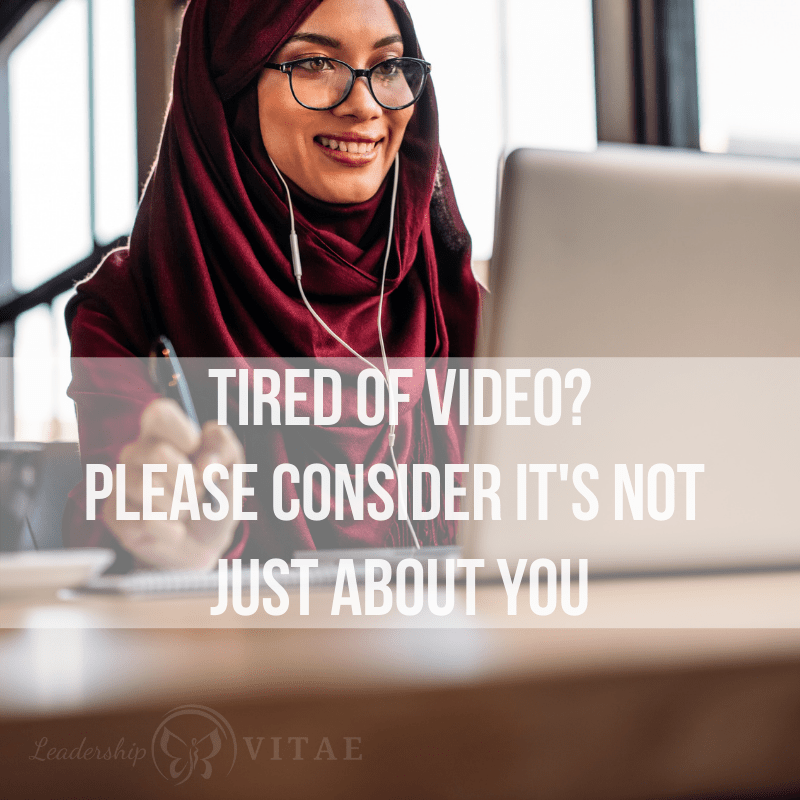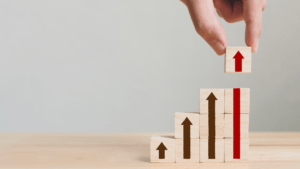
Recently I saw an article pop up on LinkedIn, talking about video conference fatigue.
A lot of us are tired. Tired of endless meetings on video. Of not seeing our colleagues face to face. Or maybe our home situation is such that video is one more distraction when we’re just trying to show up as our best selves.
I get it.
There are times when I refuse to do video.
- With colleagues I don’t know that well if my son doesn’t have class and is popping in and out of the room.
- Any time I’m eating.
- As I’m walking on my treadmill desk to finally get some movement in.
- With colleagues I do know well and I want to be able to roll my eyes into the back of my head without anyone seeing it.
I jest, a little. But I do have times when I just want to be able to relax and be present without being “on.” That has been a rare luxury with working from home.
While opting in and out of video has been a saving grace at times, there is a dark side of voice-only calls.
The opt-out
At the very beginning of the pandemic, I never joined video. I had two students in the house with me and the network was spotty. It kept dropping, even without video, so I often called into meetings on my cell phone.
When school went out, and it was just me in the house, things didn’t get better. Eventually I got the network looked at and fixed the issues that were plaguing my service.
During those few early months, my team and I struggled. I don’t think it was obvious. At least not to me. I thought we had just shifted our meetings and discussions to the phone, and assumed the trust and goodwill we had pre-pandemic would follow us through.
It was not a safe assumption to make.
That didn’t become obvious until I started using video and we could see each other. The non-verbals, which I can struggle with even face to face at times, were so much more important with the distance between us.
They could see me talk with my hands, which I do a lot. They could feel my energy through the phone, but maybe they could see my smile and enthusiasm, and realize that energy was coming from a positive place. Which was hard to recognize in a COVID threat state, with only my voice as an indicator.
Within weeks, I was getting feedback about how much better things were. Adding video allowed me to cue more off of them AND they could add in other criteria than just my words and my voice to receive me.
Diversity in communication
I am not the only one in the world that struggles with non-verbal cues.
As we’ve moved from more in-person communication to phone and/or video, it can present challenges to ANYONE.
Depending on the topic, it can be difficult to follow a verbal conversation with no visual connection. In large groups, following who is saying what and keeping the thread of the conversation? The struggle is real.
This is before we consider the needs of someone that is neuro-diverse, or may have challenges with hearing, for example. Methods and approaches to communicate in the office may not work as well virtually, and may need adjustment.
For example, we use Microsoft Teams. One of my team members turns on closed captioning so she can follow multi-person conversations. Many tools have such a feature, but some of them don’t when configured for large group settings. This can make it difficult to follow along. If video is used, she can focus on the speaker, and it becomes easier for her.
But what if the speakers turn video off? Some of us need video as a way to follow a conversation.
The dark and light side of video
As a leader, I find it helps to see someone, even if I’d prefer to keep video off. Even if they do.
Right now, I’m tired and trying to power through to the holidays. There are changes coming in our organization, and we are in the final stretch. I’d prefer not to be “on” if I don’t have to be.
Yet, if I put on the camera with my peers, I can see the same exhaustion. They can see their tired look reflected, and the empathy in me. We can connect and support each other.
My team can see my son pop into my office and me shooing him back to class. It irritates me, and I lose my train of thought. But my team knows they are not alone in these challenges. It gives them a moment of light-hearted humor, and reminds them that I’m human too.
So many times, video has been the first time I’ve seen someone’s face in months. The joy that brings me, and the return smile I receive when they realize how happy I am to SEE them… Well, this introvert occasionally does like to be around people. I didn’t realize how much until I couldn’t do it.
For every moment that video can frustrate, or feel like a burden, it can also make a huge positive difference for us and others. It may be a better way for another person to understand us. It may be a way to genuinely connect, in a time when we have few others.
Maybe, just maybe, it’s the best way to see and be seen right now. To hear and be heard.
The new normal
We are not going back to “normal” anytime soon, and likely never quite like things were. Distanced partnerships and interaction are a growing part of our future.
Being “on” with video can take a toll, as the virus and “distanced everything” has. Before eschewing it, consider the potential value by asking a few questions:
- Will this help me connect better with the other participant(s)?
- When is the last time I’ve “seen” this person or people?
- Who is on the call? Will anyone be able to process, engage, and receive me and/or this information better via video? Will I?
- Are slides, or other shareable content, available to anchor the listener in lieu of a person’s face?
- Is there time at the beginning or end of a discussion when video can be used to connect – similar to the human moments at the beginning of an in person meeting – and then turned off for the rest of the content?
- Am I a leader, and what am I modeling?
While we may be fatigued by COVID, working remote, distanced learning, and all the “new” in our lives, there is opportunity. We can react to the fatigue, or be purposeful in where we put our energy.
As we evaluate our day, and the potential of endless meetings, it is worth asking a few questions to determine who would benefit most from video. Intentionally and selectively using it can create big impact, while still conserving energy (and our sanity in the case of a chaotic house).
If we remember nothing else, it’s that communication is about a sender AND receiver. No matter what we decide, it’s never just about us.
* * *
Do you have a method for determining when to use video? What is your evaluation criteria? Please share your thoughts and experiences in the comments.
[/et_pb_text][/et_pb_column] [/et_pb_row] [/et_pb_section]








2 Responses
Thank you for sharing. In the almost 10 months of this remote work, my boss has been on video about 4 times, I had to suggest we all at least say “hello” before our management meeting. She is doing a little better. I ask my team to say hello via video and if they choose to stay on they can.
That’s a great idea. I’m trying to do the same. What I’ve done also is tell my team that I get on video because we’re going through a lot of change and I think it’s important for them to see me, rather than just hear a voice, so they can get the other side of non-verbal communication. When I do that, I often get a few people that come onto video to do the same. Thank you for sharing!